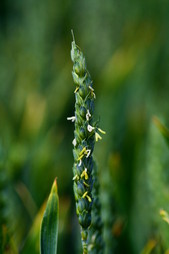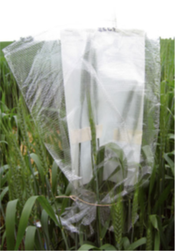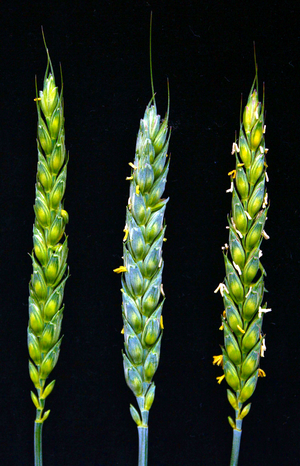Bottleneck – pollination capability of wheat
Hybrid seed production in wheat is expensive, thus providing a main obstacle for the shift from line to hybrid breeding. Improved hybrid seed production requires the redesign of wheat floral characteristics to enforce sufficient outcrossing in this selfing species. Pollen shedding was identified as the major problem in wheat and the identification of lines with favorable male floral characteristics required for hybrid seed production currently poses a severe bottleneck for hybrid wheat breeding. Historically, commercial hybrid wheat breeding was based on very few wheat male lines – while the variety “Piko” is still one of the most famous ones.

Wheat variety "Piko"
Phenotypic evaluation of required traits
Phenotyping the quantity of pollen produced per wheat plant and its dispersal outside the floret is difficult and time-consuming, preventing routine high-throughput screening in breeding programs. Our aim is therefore to investigate numerous direct and indirect traits facilitating phenotyping of the pollen quantity. The most promising approach identified yet is pollen mass, which was determined by weighting the pollen released from four ears into a paper bag across the whole flowering period. This trait has a high heritability and can be much easier measured in the field than other more technical approaches. For instance, in contrast to the use of pollen traps it does not require isolation from other wheat lines, thus it can easily be performed in each nursery.

Collecting pollen to assess pollen mass
However, it still takes around 10 minutes to screen one genotype. Consequently, we recommend to screen the large number of lines available in a breeding program first for visual anther extrusion. Only the best ones can then be phenotyped for anther extrusion and/or pollen mass.
Besides these technical things, we also had some important findings concerning breeding purposes. Although many wheat lines have poor pollination capability, we identified a significant genetic variation in elite wheat lines with few lines of outstanding pollination capability. Heritability of the trait seems to be fairly high, nevertheless the significant genotype × environment interaction requires multi-location screenings.
Genetic architecture of male floral traits
The detection of quantitative trait loci (QTL) is of direct importance for knowledge-based breeding approaches. In theory, the main advantage of genomics-assisted breeding is the significant acceleration of breeding programs. Apparently, this strategy is very interesting for traits which are laborious to assess like pollen mass or anther extrusion. Since little was known on the genetic architecture of male floral traits, we employed a panel of 209 diverse winter wheat lines assessed for pollen mass and anther extrusion, and genotyped with genome-wide markers as well as for Rht-D1 and Rht-B1.
We observed a broad phenotypic variation for anther extrusion and pollen mass. High heritabilities also underscore the reliable performance of the phenotyping methods as well as the usefulness of these traits for selection.

Phenotypic variation of anther extrusion in wheat
The genome-wide scan revealed a complex genetic architecture underlying these traits, for which Rht-D1 was identified as the only major QTL. Interestingly, our results showed that the wild-type Rht-D1a allele (tall phenotype) has positive effects on floral traits like anther extrusion or pollen mass. This finding is rather beneficial for hybrid breeding programs since male lines are desired to be taller than female lines.
In a second step, we applied genomic prediction, fitting the identified major- and medium-effect QTL as fixed effects, which yielded the highest prediction accuracies for male floral traits and outperformed marker-assisted selection. Finally, we integrated these findings in an initial concept for male pool development in wheat and demonstrate how the genomics-assisted broadening of the male pool might be achieved by our HyBFrame approach in the long run (see item heterotic groups).
